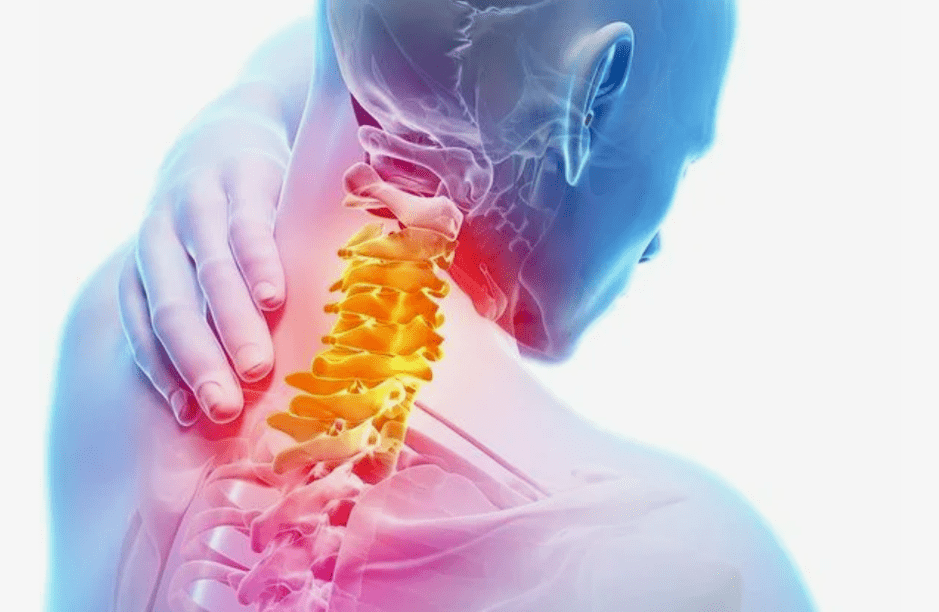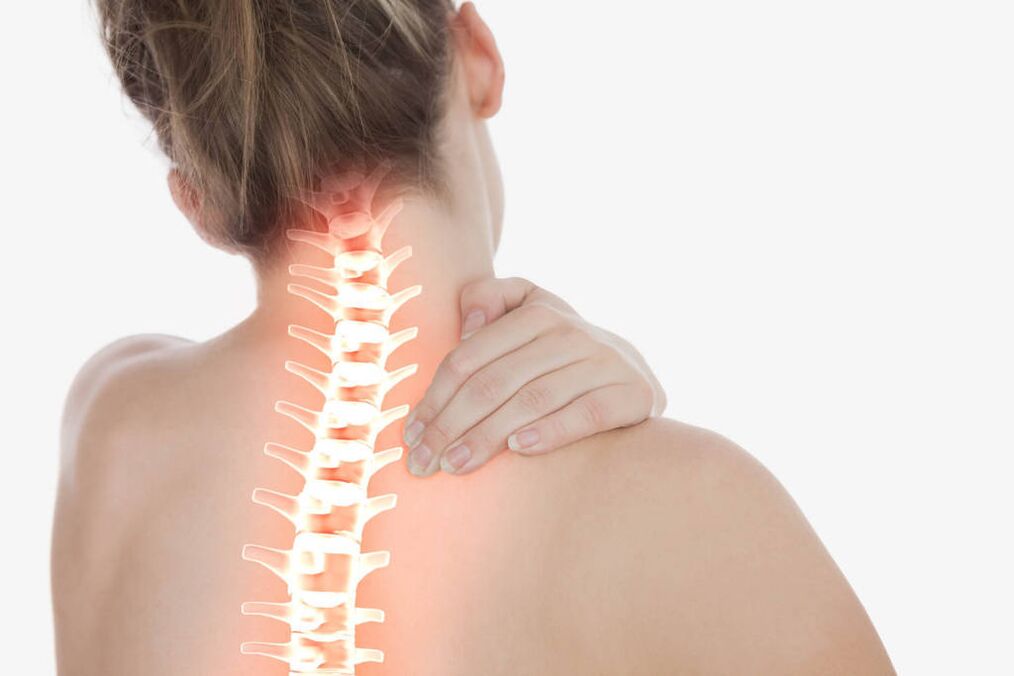Osteochondrosis is a common pathology of the spine, characterized by the dystrophic change of the structure of the cartilage discs of the spine and the basis of their bone. To one or another degree, osteochondrosis is manifested in most people after 30 years. Symptoms of cervical osteochondrosis are varied, which often complicates the diagnosis and subsequent treatment.

General symptoms and signs of cervical osteochondrosis
This process affects any spine or several at once. Lumbar and cervical vertebrates are most affected by pathologies, which are most susceptible to human skeletal anatomy. Results of spinal osteochondrosis in the cervical region cause the most inconvenience and potential complications, as the neck is a rich area rich in neuromusic highways, most of which are fed directly to the brain.
For this reason, the clinical symptoms that have cervical osteochondrosis are many associated with ischemia of the brain area. In addition, nerve roots that provide sensitivity to the hands and shoulder girdle and motor action, when weakening of the distracted vertebrates can have a variety of symptomatic images.
Signs of osteochondrosis of the neck depend on which body systems are affected by the pathology:
- Due to the contraction of the disruption of blood circulation, most of the symptoms and signs from the brain are determined.
- Compression of the roots of leaving vertebrates gives a picture of damage to the peripheral nerves.
- Pinking of spinal cord areas is associated with severe neurological pathologies found in advanced cases.
Below, consider the general clinic of the cervical spine osteochondrosis.
Pain in the back of the head, neck and collar area
This is the most common symptom. Pain localization can be enlarged, affecting shoulders, claves, chest, intense migraine. The nature of the pain depends on the localization of the lesions and the severity of the pathology. Initially, the pain can be quickly transient, gradually becoming chronic, aching. At times of exacerbations, the pain occurs in shooting, with increased tone of the neck muscles and its limited movement.
Often, cervical osteochondrosis may be localized behind the sternum, in which case many patients receive this symptom for angina pectar. Differentiation can be carried out by taking nitroglycerin pills - pain due to osteochondrosis, they are not removed.
Noise, call, feeling swelling in the ears
These symptoms often join hearing loss. These phenomena are associated with a decrease in blood flow from the spine arteries to vestibular. The complex of these symptoms is called cochlear, or snails syndrome, and it is always far from the cervical region to determine its connection with osteochondrosis. A specific feature for differentiation is that noise, swelling and call in the ears are felt when changing position, after a long stay in one position.
Dizziness
Dizziness is also due to disruption of blood flow to the inner ear organs, which ensures the body's balance. Nystagm often joins dizziness - arbitrary fluctuations in the eye students.
The lack of air
This feeling is evident due to irritation of the ends of the diaphragmatic nerve. It is a component of the cervical nerve beam and participates in the regulation of breathing, its depth and frequency. Patients complain about the impossibility of complete breathing of the chest. In some cases, this symptom exacerbates the severe lack of breathing and robbery. For the same reason, breathing stops at night and snakes. Due to breathing problems, the disadvantage of oxygen is finally the cause of increased fatigue, decreased concentration and memory problems.

Nausea
It is accompanied by a belching air. Also due to blood circulation problems in some areas of the brain and inner ears. Nausea is sometimes observed by vulnerable vessels caused by head and body movements. Often nausea and vomiting are appetite, weight loss, alimental failure.
Vision problems
In the eyes "flys", decreased visual gravity, fog in front of the eyes - all this is a symptom of ischemia of the brain area, which is responsible for vision. Patients with osteochondrosis are less likely to complain about sight, as the lack of blood supply from the spine vessels is reimbursed from the carbon arteries system from the blood flow. Glasses and therapeutic gymnastics do not solve the problem for eye muscles, usually vision improves after treatment with osteochondrosis.
What are the most important symptoms of osteochondrosis are briefly stated in this video:
Blood pressure plaque
The unstable level of pressure is caused by a long-term blood decay, which is responsible for the functions of the vascular-drown center.
Sudden discoloration, or syncopal conditions
This is found in the spasm of the arteries of the brain due to the short -term suspension of blood flow along the arteries of the spine. From the condition of the patient's consciousness, you can quickly remove it so that the legs are slightly higher than the head - the blood flow of the brain allows a person to cause life. After discontinuation, reversible problems with speech and movement, due to the short stop of blood flow, can be observed for some time.
Green symptoms
Often this may be the only sign that indicates cervical osteochondrosis. They are manifested as sweating, dryness and throat tumor, difficulty swallowing. Symptoms are associated with nerve plexus compression, which is responsible for the innervation of the pharynx. It is necessary to differentiate such manifestations from a similar clinic for inflammation or neoplasms.
Raising body temperature
Increased body temperature for cervical osteochondrosis is not the most typical symptom, it is rarely and locally observed: the cervical and collar, slight redness of the skin.
The osteochondrosis clinic in the cervical spine can be, first of all, to varying degrees of severity, depending on the stage of development of the pathology, as well as during the exacerbation, they are clearer and second to form in certain syndromes.

Symptoms depend on the stage of cervical osteochondrosis
Stage I
The beginning of degenerative processes in the cartilage of the spine discs. Symptoms are weak, sometimes it may not be observed at all. The first signs of cervical spine osteochondrosis:
- Discomfort in the neck, arms, shoulders, and sometimes pain;
- Headache;
- Easy restriction of neck motor action;
- Rapid passage of visual failure;
- Reduce skin sensitivity to the collar area.
Important: These symptoms become more pronounced during head tilt.
Typically, in the first stage of osteochondrosis of the cervical region, patients do not go to the doctor, considering that all symptoms are associated with fatigue, stress, age, lack of sleep.
Stage II
At this stage, the spine protrusion began, intervertebral cracks are destroyed, the fiber fiber fibrous fibrous fiber in the collagen disc is destroyed. Due to the compression of nerve trunks, the dotted nature is noticeable painful symptoms, during the movement of the neck and in turn. Here you can already question cervical osteochondrosis, the symptoms of which are as follows:
- Expressed pain in the neck, sometimes with crunch;
- The skin of the shoulders and hands almost completely loses sensitivity;
- Headaches are common, do not last long;
- Visual impairment in the eyes with "owls";
- Call and noise in the ears;
- Weakness of the upper extremity muscles;
- The clarity of tendon reflexes decreases;
- Shooting pain with shoulder knife dedication;
- Sore throat, swallowing problems;
- Sleep disorders, usually insomnia.
Long in one condition causes severe pain. At this stage of disease development, patients are already going to the doctor for help.
Stage III
The disk fibrous rim is destroyed, a hernia is formed. In the third stage, due to weak fixation, they are deformed by the spine, movement and dislocation. The symptoms are as follows:
- Intense, severe pain in the neck, collar area, heart area;
- Scalp sensitivity to the back of the head, in the shoulder region, in the hands, to complete absence;
- Cervical spine hernia;
- Upper extremity parasites and paralysis;
- Tender reflexes have virtually no observed.
This is a severe stage of the disease in which the patient can no longer support himself. Spinal cord ischemia and contraction of the spine arteries cause complete inability to move and reduce the muscles in other parts of the body, as well as a decrease in spinal cord.

How to treat cervical osteochondrosis
The condition of the spine is a very serious pathology that neglects disability and deep disorders of the cerebral circulation - and death. For this reason, in the case of such symptoms, you should not do it. Osteochondrosis is treated in the hospital and at home exclusively as a doctor's prescription. Initially, cervical osteochondrosis treatment is conservative, including medication prescriptions: non -anti -ankle agents, anesthetics, hormonal medications, vitamins complexes, joint medications -relieves inflammation, pain, improves soft tissue trophy and trophy.
In the acute period, the form of drug injections is prescribed as the pain stops, the patient goes to the tablets. Physiotherapy, massage, exercise exercises that are usually prescribed at the remission stage, join the drug courses. In difficult cases, osteochondrosis is treated with surgery.
































